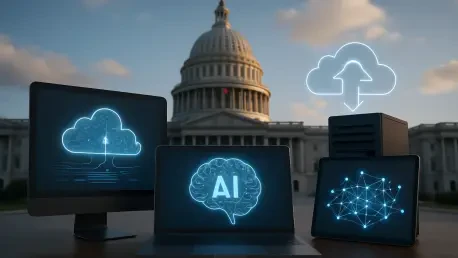In an era where public expectations for government efficiency and transparency are at an all-time high, the integration of advanced technologies like artificial intelligence (AI) and cloud computing is no longer optional but essential for transformation. Across state agencies, educational institutions, defense sectors, and federal programs, leaders face mounting pressure to deliver services that are not only faster and more secure but also responsive to the needs of citizens in real time. However, the path to achieving this vision is fraught with challenges, including outdated systems, escalating cyber threats, and a scarcity of skilled talent in critical areas. The convergence of cloud innovation and AI capabilities offers a promising solution, enabling a smarter approach to governance that aligns technology with mission-critical outcomes. This shift is not just about upgrading infrastructure; it’s about reimagining how public services can meet modern demands through intelligent systems, setting the stage for a deeper exploration of how these tools are already reshaping the public sector.
1. Addressing Legacy Challenges in Government Systems
Government infrastructure, often rooted in decades-old technology, continues to drain IT budgets while failing to meet the demands of a digital age where speed and scalability are paramount. Many systems lack the interoperability needed to support seamless communication across agencies, creating bottlenecks that hinder efficiency. As budgets are consumed by maintenance rather than innovation, the gap between capability and expectation widens. This outdated framework struggles to adapt to the rapid pace of technological change, leaving agencies vulnerable to inefficiencies that could be mitigated with modern solutions. The financial burden of maintaining these systems often overshadows the potential for transformative investments in newer, more agile platforms that could better serve public needs.
Beyond the constraints of legacy systems, the expectations of citizens and stakeholders have evolved dramatically, demanding real-time access to services and information from government entities. This shift is compounded by specific hurdles such as fragmented systems that limit performance, isolated data silos that prevent cross-agency collaboration, and increasing cybersecurity risks that threaten sensitive information. Additionally, a shortage of expertise in cloud computing, AI, and cybersecurity exacerbates these issues, leading to operational delays and a decline in public trust. Addressing these challenges requires a strategic overhaul that prioritizes modernization with intelligence, ensuring that technology not only updates but also anticipates and adapts to future needs.
2. Crafting a Smart Government Strategy
Modernizing government operations without embedding intelligence is akin to relocating problems to a new platform without solving them; true transformation demands infrastructure that adapts, secures, and responds to dynamic challenges. Agencies need systems designed to evolve with emerging threats and opportunities, ensuring that public services remain robust under pressure. This approach goes beyond mere migration to create environments where data flows freely, decisions are informed by real-time insights, and security is an inherent feature rather than an afterthought. Collaboration with experienced IT solution providers becomes critical in this context, as their expertise can significantly enhance the speed and success of implementation, turning complex transitions into streamlined processes.
Specialized providers bring tailored offerings that are vital for smart government initiatives, including cloud-native modernization through secure platforms and programs designed for public sector needs. These solutions often incorporate generative AI and intelligent automation customized for government use cases, alongside unified data architectures that enable instant decision-making across jurisdictions. Security frameworks aligned with stringent standards ensure compliance while protecting against threats. Such comprehensive strategies, built on decades of public sector experience, provide agencies with the tools to not only modernize but also to anticipate and address the unique demands of governance in a digital landscape.
3. Demonstrating Real-World Impact
The transformative potential of AI and cloud technologies is already evident in practical applications across various public sector engagements, showcasing measurable improvements in service delivery. For instance, a state Department of Motor Vehicles adopted a modernized contact center solution, evolving into an omnichannel hub that leverages self-service bots for routine tasks like appointment scheduling and renewals. This shift has dramatically reduced call volumes for agents and shortened wait times for citizens, allowing staff to focus on more complex inquiries. Such implementations highlight how intelligent systems can enhance accessibility and efficiency, directly benefiting the public while optimizing internal resources for more critical functions.
Similarly, a Public Utility Commission has harnessed AI-driven automation and cloud-based data solutions to revolutionize utility regulation and grid modernization efforts. By utilizing a robust cloud foundation, the agency has accelerated real-time analysis of infrastructure data, improving oversight and transparency in energy programs. This capability ensures better compliance with regulatory standards and enhances visibility into operations, fostering public confidence in utility management. These operational success stories underscore the tangible benefits of integrating advanced technologies, proving that smart modernization can address longstanding inefficiencies and pave the way for broader adoption across government sectors.
4. Strategic Steps for Intelligent Modernization
For public sector leaders aiming to modernize with both intelligence and efficiency, adopting a structured, incremental approach to transformation is essential, leveraging established frameworks and funding programs tailored for government needs. This involves modular upgrades that prioritize agility, allowing agencies to adapt systems step by step without overwhelming existing operations. Such a strategy ensures that modernization efforts are sustainable and aligned with mission goals, minimizing disruption while maximizing impact. By focusing on proven blueprints for cloud integration, agencies can build resilient infrastructures that support long-term scalability and innovation, setting a foundation for future advancements.
Another critical step is deploying AI with carefully designed guardrails to ensure relevance and compliance, targeting high-value applications such as content summarization, policy drafting, and digital assistance. Simultaneously, empowering the workforce with intelligent tools like AI agents and automated workflows can augment staff capabilities without replacing human expertise, supported by change management practices. Additionally, embedding security by design through native threat detection and strict access controls, reinforced by AI-enhanced monitoring and Zero Trust models, ensures that modernization efforts are protected from evolving cyber risks. These combined actions provide a comprehensive roadmap for agencies to achieve smarter, more secure governance.
5. Leveraging a Powerful Partnership for Transformation
The collaboration between seasoned public sector solution providers and leading cloud technology platforms offers a unique advantage, combining decades of specialized experience with cutting-edge innovation recognized for excellence in AI competency. This partnership delivers secure, compliant infrastructure through advanced services and controls, alongside AI enablement tailored for government applications. Sector-specific solutions address the distinct needs of areas like public safety, education, healthcare, and defense, while financial and optimization support ensures cost-effective transitions. Comprehensive services spanning readiness, architecture, deployment, and ongoing management further enhance the ability of agencies to execute complex modernization projects with confidence.
This synergy provides scalability through robust cloud ecosystems while ensuring mission alignment through strategic expertise and detailed planning. The result is a tailored approach that not only meets current demands but also anticipates future challenges, enabling government entities to operate at peak efficiency. By integrating vast technological capabilities with deep public sector insight, this collaboration ensures that modernization efforts are both impactful and sustainable, delivering infrastructure that supports real-time decision-making and long-term resilience across diverse governmental functions.
6. Understanding the Broader Significance
The essence of smart government lies in its ability to fundamentally improve service delivery, ensuring that citizens experience faster, more transparent, and intuitive interactions with public agencies. This transformation means that routine processes become more accessible, reducing frustration and enhancing trust in government operations. Employees benefit from the alleviation of repetitive tasks, supported by intelligent tools that allow them to focus on higher-value work that directly impacts mission outcomes. For leaders, the advantage is clear: real-time visibility and control over programs and platforms enable more informed decision-making and strategic oversight, critical for addressing complex public needs.
This model of governance aligns with the expectations of a digitally savvy public, where responsiveness and accountability are non-negotiable standards for government performance. The integration of AI and cloud technologies has already demonstrated its capacity to meet these demands, proving that such advancements are within reach for agencies ready to embrace change. As these solutions continue to evolve, they promise to redefine the relationship between citizens and their government, fostering an environment where technology serves as a bridge to better public outcomes and sustained trust.
7. Reflecting on Achieved Milestones
Looking back, the journey toward smarter government through AI and cloud technologies revealed a landscape of both challenge and opportunity, where initial steps taken by pioneering agencies set a powerful precedent for others to follow. Success stories, such as the transformation of contact centers and utility commissions, showcased how strategic modernization efforts tackled inefficiencies and elevated service standards in meaningful ways. These early adopters demonstrated that integrating intelligent systems was not just feasible but also impactful, providing a blueprint for broader implementation across diverse public sectors.
As these initiatives unfolded, the focus remained on building adaptive infrastructures that prioritized security and scalability, ensuring that past limitations of legacy systems were effectively addressed. The collaboration between technology providers and government entities proved instrumental in navigating complex transitions, embedding compliance and innovation into every phase of deployment. Moving forward, the emphasis should be on scaling these proven strategies, exploring additional use cases for AI, and fostering continuous learning to keep pace with emerging needs, ensuring that the momentum of transformation continues to deliver value to the public.









